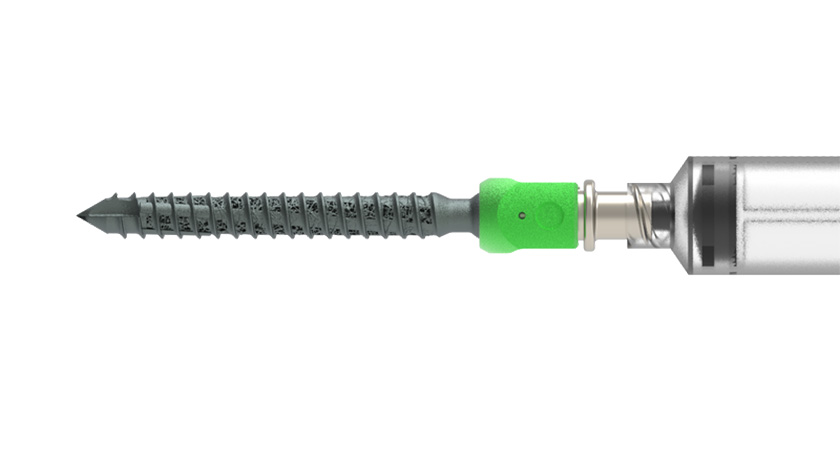
Sterile-packaged orthopedic implants and instruments are not new, but the trend has picked up recently. Though the concept was first commercialized nearly 30 years ago, today, sterile, single-use orthopedic devices can credit their momentum to various market dynamics.
Tyber Medical, an OEM private label company, is well-versed in helping orthopedic device companies bring sterile devices to market. Since product development is a team effort, we spoke with multiple members of the Tyber Medical team to get an idea of how other orthopedic device companies can make the switch from non-sterile to sterile.
But First, Why?
We know that sterile packaging is a hot topic today, but why should orthopedic device companies consider offering these products? The reality is that a combination of factors makes sterile devices attractive.
One market force is that ASCs are increasingly popular settings for orthopedic surgeries, yet the space limitations of these facilities mean difficulty holding excess inventory.
“ASCs don’t have as well resourced and robust central processing for reusable sets,” said Chris Faresich, Senior Project Engineer at Tyber Medical. “Having a sterile system allows them to complete more cases in a day and turn over the O.R. faster. And it’s also easier on their storage and their central processing.”
Aside from the lack of space, the efficiencies realized from sterile products are potentially enormous.
“If you have five surgeries in the day for the same procedure, you’re going to be running a tray for sterile processing five times,” said Mark Schenk, Vice President of Regulatory at Tyber Medical. “Whereas if you have sterile kits on the shelf, you can do as many surgeries in the day as you can fit in. You just pull a new kit off-the-shelf and discard it afterward.”
These factors, coupled with the high cost of maintaining inventory in the field and an ever-evolving regulatory landscape, are causing the rate of single-use, sterile device adoption to speed up.
“The big gorilla in the room, regulatory wise, is the Medical Device Regulation in Europe,” Schenk said. “With the increased scrutiny on reusable surgical instruments and the sterilization associated with them, some companies are using that as motivation to move to sterile instrument kits.”
Though Schenk does not anticipate the U.S. FDA mirroring the European regulations, they will still have an impact on any device company that operates across international lines.
“It makes sense in the USA in a lot of cases to have the sterile option, even if the regulatory requirements aren’t there,” Schenk said. “Often when a multinational company does something, they do it globally.”
In addition to these factors, sterile implants can often make things simpler in the O.R. Orthopedic surgeries that require minimal instrumentation or that aren’t highly specialized and costly could benefit from sterile medical devices.
“It’s easier to keep track of the unique device identifier (UDI) on a sterile kit because it’s right there on the label,” Schenk said. “Whereas if you have implants in the implant caddy, or the sterilization tray some people put tags on, some people have a sheet that gives the DI portion of the UDI. It’s not as straightforward as a sterile implant.”
There’s one other (fairly large) nice-to-have: Surgeons are getting a fresh set of devices every time with single-use sterile packaging. There’s no risk for error in the sterilization process and, therefore, less of a chance for infection.
“From a patient safety standpoint, sterile products are the gold standard,” Faresich said. “And I think would be the preferred system for the end user, which is the surgeon.”
A Step-By-Step Guide to Switching to Sterile Devices
Several considerations have to be taken into account when a company decides to switch from non-sterile to sterile devices. At a high level, companies will be looking at three things: kit or package design, regulatory requirements like validation and testing and sterilization methods.
Overall, the Tyber Medical team said making the switch is similar to processes that orthopedic device companies are already familiar with.
“If I was offering advice to other OEMs, I would encourage the movement toward sterile devices. But I recommend doing it in an organized approach just like you would for any medical device development,” said Patrick Reese, Design Quality Engineer at Tyber Medical. “It’s the exact same validations. As long as you have a regulatory person keeping an eye on things, then everything you need on the label can all fall into place pretty well.”
Kitting and Packaging Design
How you package or kit your sterile device is an important first step in the process. The sterile barrier or pouch material and size need to be determined at the forefront, as well as the contents of the package.
“Think about: Is your device an inch in length? Is it 12 inches in length? What’s the weight of it? Are there any sharp features that need to have tip protection?” Faresich said. “Beyond that, think about how you want to configure the kit — do you want to have all of the instrumentation combined with the implant, or should the implant be separate?”
There are several options for how you’ll package your implants and instruments and ways you can create efficiencies.
“The transition from non-sterile to sterile is kind of a fun one, because you can go multiple paths,” Schenk said. “You can move to a variety of different packaging configurations from off-the-shelf trays with Tyvek Lids to custom designed trays that have an outer tray that is common to whatever’s going in it, and then the inner tray can be swapped out.”
The type of packaging you choose can benefit your validation efforts if designed strategically.
“For security, you can use either shrink wrap or tamper tags as tamper evidence seals, and you also want to leverage as much testing as you can where you can,” Boger said. “I would say don’t have packaging be an afterthought; make sure it’s brought in upfront in the beginning stages.”
Validation and Testing Considerations
Sterile packaging requires extensive validation and must meet strict regulatory standards. Knowing the requirements at the forefront speeds up time to market and protects the bottom line.
“We find that preparation upfront in planning your packaging pays dividends,” Schenk said. “Plan upfront, do research on what you’re using for the packaging system, put a lot of thought process into how whatever you’re sterilizing fits into the packaging configuration and give yourself the best chance to have successful validations — especially in accelerated aging and transit tests.”
It’s helpful to start with the customers, the market, and the end user and work backward from there to prepare your packaging, Faresich said. Consider your current products and what you expect to be in your pipeline. Then make sure the packaging type that you select aligns with your system before laying out your test plan and validations to cover everything you’re currently packaging, plan to package, or may package in the future. Then, put together a testing plan.
“For sterile products, there is a minimum test plan that we adhere to,” Faresich said. “For the design of the packaging, that’s ensuring that the packaging contents can be sterilized to an acceptable level. Then there’s transportation validation, which ensures that the package and sterile barrier maintain their integrity throughout the expected distribution of the package. And then you also have a shelf life, or aging qualification, and this ensures that the packaging and sterile barrier maintain their integrity over the expected life of the product.”
Typically, there is a five-year expected shelf life. A company will complete both accelerated and real-time aging on the packaging system to ensure that the quality is maintained.
“Speaking from experience, sterile packaging validations do take a long time,” Faresich said. “Aging testing is going to be your longest component. If you validate something that you don’t expect to use in the future or won’t cover a product down the road, you have to restart the clock on the validation. That can cost your business a lot of time in terms of getting to market.”
Once you do move to sterile packaging, keep an eye on the package expiration date on a regular basis to stay compliant.
“A key to switching from non-sterile to sterile devices is taking into consideration the timing for accelerated and real time aging studies to make sure you build that into your timeline,” said Kim Boger, Senior Packaging Engineer at Tyber Medical. “When you’re going to launch something, you want to make sure it’s built into your timeline and you can add a little buffer time to make sure you’re covered all the way through.”
Sterilization
Clearly, the crux of the benefits of sterile devices is the sterilization itself. Having single-use, safe orthopedic implants and instruments reduces the need for repetitive sterilization processes between uses and the potential for introducing contaminants that lead to infection. Companies making the switch need to closely consider what their own sterilization process will look like.
Orthopedic device companies will take on added responsibility when they move to sterile packaging, Reese said. Companies need to consider best practices, especially from a quality perspective, when they perform sterilization.
Typically, gamma radiation, x-ray, or Ethylene Oxide gas (EtO) is used in the sterilization process prior to packaging. A rigorous quality management system should be in place to maintain sterility throughout the entire manufacturing and distribution process. The Tyber Medical team recommends dose auditing in which a company measures products regularly for the different qualities of how sterile the product is after it goes through sterilization cycles.
How to Scale Sterile Device Production
Once you’ve outlined your process, the next question before taking the leap is, of course, how to scale. This is rooted heavily in planning and forecasting to keep production, inventory and equipment at the right levels.
“Listen to the market and plan ahead for what products you currently have in your portfolio, but also what products you may expect to see down the road,” Faresich said. “That way, you can account for that in your initial testing of your packaging so you don’t have to retest when those new systems come into play.”
Consider your equipment and your capabilities as your business scales. You may have a tray sealer, for example, that can handle volumes at the beginning but may be strained as you grow. Your cleanroom may need to be larger. You may need additional machinery, storage locations or suppliers.
Beyond that, make sure your partners are aligning their business and their growth in scaling properly to meet those needs down the road. You don’t want to surprise them when volumes increase and new products come on board.
“It comes down to listening to your customers, listening to the market, and then making sure that your growth plan and your business is operationally aligned to accommodate and meet the needs of your customers,” Faresich said.
Maintaining inventory levels is a big part of that. Too little inventory can leave surgeons in a lurch, while too much can be costly and wasteful.
“As far as inventory goes, you don’t want to plan for having lots of sterile shipments go out and not everything being used,” Reese said. “That just reduces the shelf life for everything that you sterilize.”
When considering switching to sterile orthopedic devices, the key is to have a solid plan in place from design through distribution, the same way it’s done for non-sterile devices.
HT
Heather Tunstall is a BONEZONE Contributor.




